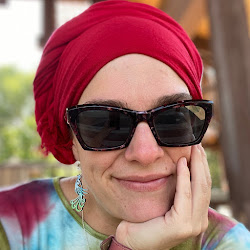In early 2005, I was visiting Chicago when I popped in to the Spertus Jewish Museum. While perusing the gift shop, I happ'd upon shelves of these tiny little rectangular boxes in all colors with embellishments like jewels, embossed letters -- you name it. Some had letters that spelled out Sha
I left that day without asking the nice lady behind the counter what they were, and I didn't really think about it the r est of the trip. When I got back to Nebraska, for some reason, I started noticing mezuzot everywhere. The truth of it is, I knew about the mezuzah, I just didn't know the commandment behind it, nor did I know where they went or why. I knew the word, but that was about it. But now, after my encounter with dozens of mezuzot at a gift shop in Chicago, I was spotting them everywhere. It became like a game, trying to figure out what doorways in my shul had them and which didn't, and exploring why certain spaces had them and others didn't.
I didn't own a mezuzah until I converted in April 2006. The synagogue I converted through gave me the most magnificent, beautiful, pewter mezuzah (which you see in the photo here). I was elated, but kept the mezuzah packed away as I hopped from apartment room to room in Washington D.C. in the summer of 2006. Finally, when I landed my own studio apartment, I placed the mezuzah, for the first time, on my own Jewish home. I said the prayer, struggled with the hammer, and smiled at no one, knowing that this little box on my door with parchment inside screamed to the world "A JEW LIVES HERE!" (Of course, I lived in a garden apartment with a side entrance behind a gate, but still -- it was something.)
So the mezuzah -- In truth, mezuzah means "doorpost" in Hebrew. Commonly, though, people think of the mezuzah as the actual little case with the parchment that you hang on the doorpost. On the parchment is Deuteronomy 6:4-9 and 11:13-21, which consist of the "Shema Yisrael" prayer. And why do we post these verses on our doorposts? Because it's a mitzvah! Deut. 6:6 ... 6:9 say "And these words, which I command you this day, shall be upon your heart ... and you shall write them on the doorposts of your homes and upon your gates." The parchment is composed by a special scribe -- a sofer stam -- and the verses are written in special ink on special paper. The mezuzah is placed on the doorpost, on the upper third of the doorway, and typically it's angled inward (this is to accommodate the varying opinions of the sages as to whether it was meant to be vertical or horizontal, not to mention that it symbolizes G-d and Torah entering the abode). As you enter and exit the abode, as you pass through the doorway, you should place your fingers upon the mezuzah case and touch your fingers to your lips. There are a bounty of other bits and pieces about the mezuzah, but I won't delve into them all here. For example, very religious/observant families will likely have a mezuzah on every doorway -- be it a closet or bedroom -- while secular or not-as-observant individuals might just post one at the back and front door of the residence. There are a bounty of rulings about what constitutes a room, how far from the door the mezuzah should go, etc. I also recall reading something once about a mezuzah necklace being not kosher halakichly, but I can't seem to find anything on it right now.
The mezuzah can be found on the doorposts of the most religious and the most secular Jews, perhaps because the mezuzah can be the most outward sign on a home that the family within is Jewish, be it culturally, religiously, spiritually, or something in between. Chabad.org has a great "handbook" online with answers to all the questions that could possibly arise, from what rooms need a mezuzah to where to post it to what it's all about. There's also a great article over on Being Jewish about the mezuzah, not to mention this blog entry written by Leah (a guest poster here on JBC) about her mezuzah, and I think what she has to say is quite beautiful.
There are a million different Judaica sites where you can purchase mezuzot, and I'm pretty sure that just about every synagogue with even the smallest gift shop sells them. I think that the mezuzah is a beautiful symbol for Jews of all stripes, for essentially it breaks the bounds of being merely a religious Jewish artifact. As you enter and exit your home, you are reminded -- no matter how busy and flustered your mind might be -- that you are a Jew, that you have a Jewish home, no matter how you choose to make it Jewish.
In my living room, I have shelves of Jewish books. A decorative dreidel. Extra mezuzot on display in a shadow box. In my desk drawer, next to my birth certificate, is an extra kosher scroll. Above my bed is a painting of the Shema.
More important than all the Judaica is, I hope, an ability to welcome family, friends and strangers into my home. That when I pass the mezuzah on the way out of my house, I carry it with me in my actions. The Judaica helps me see that I’m Jewish and tells the world that this is a Jewish home, but without Jewish actions and Jewish living–all the menorahs in the world won’t make it a Jewish home.
So what's your mezuzah flavor?
(Edited)






